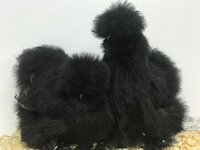- Nov 10, 2019
- 108
- 380
- 151
hello! I am a certified black silkie breeder . this I my third year in silkies and I'm kind of struggling to sustain my program. I am currently line breeding, and I'm having difficulties keeping track of generations and keeping the line pure without any inbreeding (line breeding always has its flaws) I need tips, suggestions, to how to improve my flock of silkies. I will take any advice you awesome BYC people give me. thank you!
. this I my third year in silkies and I'm kind of struggling to sustain my program. I am currently line breeding, and I'm having difficulties keeping track of generations and keeping the line pure without any inbreeding (line breeding always has its flaws) I need tips, suggestions, to how to improve my flock of silkies. I will take any advice you awesome BYC people give me. thank you!


 . this I my third year in silkies and I'm kind of struggling to sustain my program. I am currently line breeding, and I'm having difficulties keeping track of generations and keeping the line pure without any inbreeding (line breeding always has its flaws) I need tips, suggestions, to how to improve my flock of silkies. I will take any advice you awesome BYC people give me. thank you!
. this I my third year in silkies and I'm kind of struggling to sustain my program. I am currently line breeding, and I'm having difficulties keeping track of generations and keeping the line pure without any inbreeding (line breeding always has its flaws) I need tips, suggestions, to how to improve my flock of silkies. I will take any advice you awesome BYC people give me. thank you!






